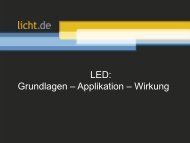licht.wissen No. 06 "Shop Lighting - Attractive and Efficient"
licht.wissen 06 provides a practical and user-oriented summary of attractive and efficient shop lighting. More information about professional lighting: www.licht.de/en
licht.wissen 06 provides a practical and user-oriented summary of attractive and efficient shop lighting. More information about professional lighting: www.licht.de/en
Create successful ePaper yourself
Turn your PDF publications into a flip-book with our unique Google optimized e-Paper software.
<strong>licht</strong>.<strong>wissen</strong> <strong>06</strong><br />
<strong>Shop</strong> <strong>Lighting</strong> – <strong>Attractive</strong> <strong>and</strong> Efficient<br />
<strong>Lighting</strong> Special: <strong>Lighting</strong> terminology<br />
The terms 'lamp' <strong>and</strong> 'light' are often confused. Lights are what the industry today calls luminaires but they are<br />
frequently referred to in common parlance as "lamps". A lamp is actually only the light source, i.e. the fitment<br />
that emits light inside a luminaire. Other terms used in lighting are also improperly understood. The following<br />
definitions shine light into the "darkness".<br />
Basic lighting variables<br />
Luminous flux Φ is the total power or quantity<br />
of visible light radiated in all directions<br />
by a light source. Measured in lumen (lm),<br />
luminous flux takes account of the brightness<br />
sensitivity of the human eye.<br />
Luminous efficacy η indicates how much<br />
luminous flux a light source generates from<br />
the electricity it consumes <strong>and</strong> is thus a<br />
measure of light source efficiency. The unit<br />
of measurement is lm/W. Any comparison<br />
of luminaires on the basis of lm/W also<br />
needs to take account of ballast losses.<br />
Luminous intensity I, measured in c<strong>and</strong>ela<br />
(cd), is the amount of luminous flux<br />
radiating in a particular direction <strong>and</strong> is<br />
defined as luminous flux per solid angle. It<br />
is significantly influenced by optical control<br />
elements such as reflectors. The radiant<br />
characteristics of a luminaire are illustrated<br />
by an intensity distribution curve (IDC).<br />
Average illuminance E<br />
20<br />
14<br />
Luminance L is the brightness of a luminous<br />
or illuminated surface as perceived<br />
by the human eye. The unit of measurement<br />
c<strong>and</strong>ela per square metre (cd/m²)<br />
indicates the degree of luminous intensity<br />
over a defined area of that surface. The<br />
luminance of an illuminated surface depends<br />
to a large extent on its reflectance.<br />
Illuminance E indicates how much luminous<br />
flux from a light source falls on a<br />
given surface. Expressed in lux (lx), this<br />
variable is used for dimensioning interior<br />
lighting; st<strong>and</strong>ard values for different applications<br />
are set out in DIN EN 12464 Parts<br />
1 <strong>and</strong> 2 "Light <strong>and</strong> lighting – <strong>Lighting</strong> for<br />
indoor <strong>and</strong> outdoor work places".<br />
Reflectance<br />
0 1 2 3 4 5<br />
Operating time in years<br />
Reflectance ρ – which depends on colour<br />
<strong>and</strong> surface finish – indicates how much of<br />
the luminous flux that strikes a surface is<br />
reflected. The brighter <strong>and</strong>/or smoother the<br />
surface, the greater the reflectance <strong>and</strong><br />
the brighter the surroundings as a result.<br />
With white walls <strong>and</strong> ceilings, reflectance<br />
can be as high as 90 percent.<br />
Illuminance on installation<br />
Maintained illuminance<br />
System illuminance<br />
without maintenance<br />
© <strong>licht</strong>.de<br />
Glare<br />
Glare reduces visual performance <strong>and</strong><br />
visual comfort <strong>and</strong> can thus impair visibility.<br />
Direct glare is caused by luminaires or<br />
by very bright daylight. Glare can also be<br />
caused indirectly by light reflecting from<br />
shiny surfaces. In luminaires, light sources<br />
are shielded along lines of sight.<br />
Light colours<br />
The light colour of a light source determines<br />
the atmosphere in a room. The<br />
defining variable is the colour temperature<br />
of the artificial light source, expressed<br />
in kelvin (K). Low temperatures make for<br />
warm lighting, higher ones for a cooler ambience.<br />
The most widely used light colours<br />
are warm white (below 3,300 K), neutral<br />
white (3,300 to 5,300 K) <strong>and</strong> daylight white<br />
(over 5,300 K). Warm white light is predominantly<br />
used to emphasise reds <strong>and</strong><br />
yellows. Blues <strong>and</strong> greens are accentuated<br />
at higher temperatures.<br />
Colour rendering<br />
The colour rendering index R a<br />
indicates<br />
how accurately colours are rendered by<br />
artificial lighting. Under the light of a lamp<br />
with a R a<br />
rating of 100, all colours look<br />
perfectly natural. Colour rendering index<br />
depends largely on the spectral composition<br />
of the artificial light, i.e. on the type<br />
<strong>and</strong> quality of the light source. Halogen<br />
lamps have the best R a<br />
rating of all (100);<br />
metal halide lamps, fluorescent lamps <strong>and</strong><br />
energy-saving lamps achieve very good<br />
ratings between 80 <strong>and</strong> 90.<br />
Maintained illuminance<br />
Maintained illuminance is the average<br />
illuminance that needs to be maintained<br />
as a minimum at all times. During the<br />
life of a lighting installation, illuminance

















